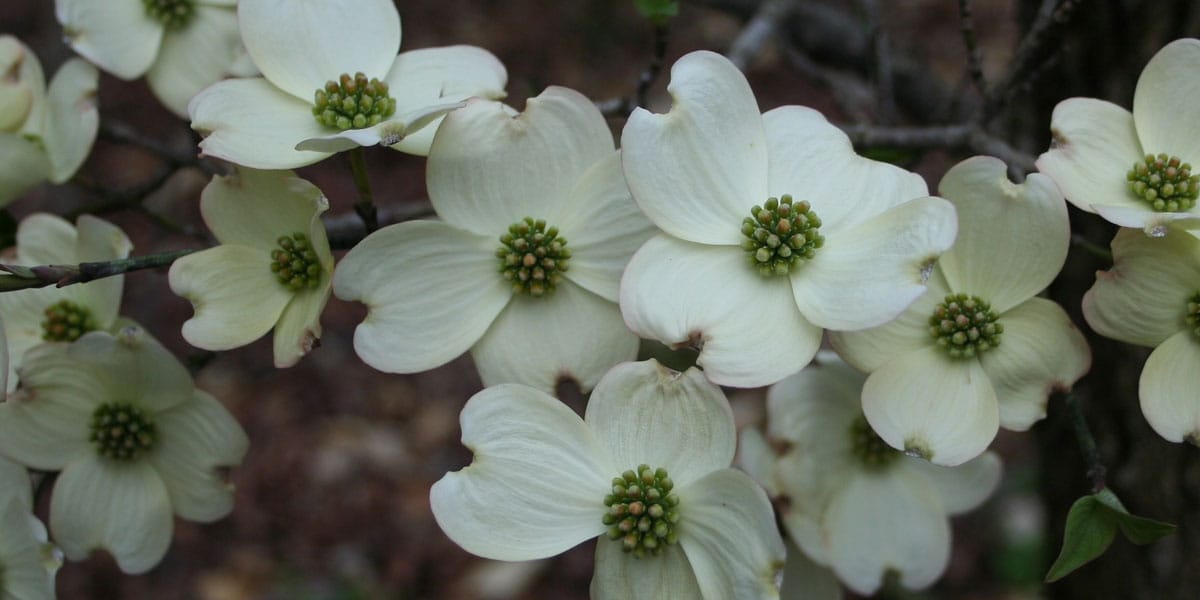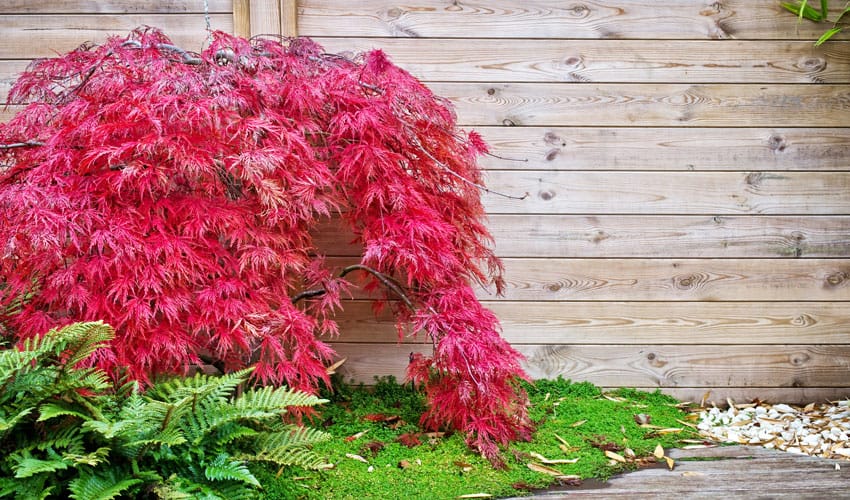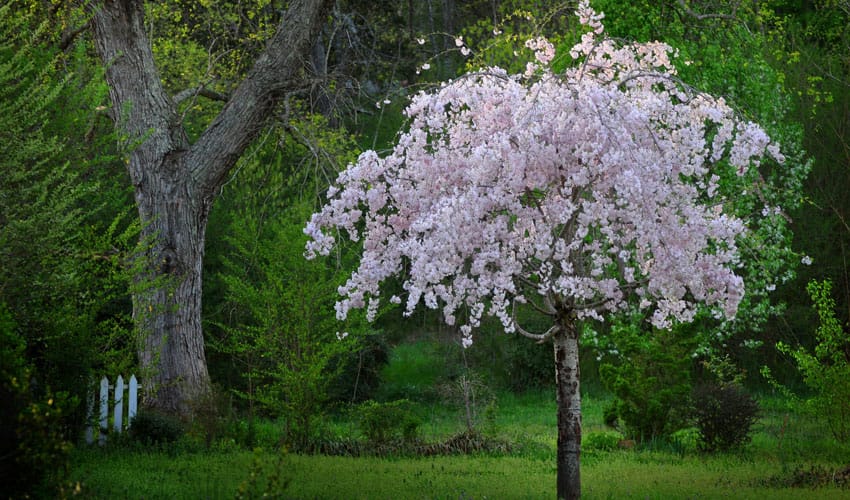Think having a small yard means you can’t enjoy the beauty and benefits of trees? Think again! Small trees for smaller spaces are the perfect solution, offering shade, seasonal color, and charm without crowding your landscape. With a wide variety of species and cultivars available in Northern Virginia, you can find the perfect match for any landscaping theme.
PRO TIP: Want even more choices of trees for your yard? We’ve previously written several articles about picking trees. Give them a read for more options on tree planting:
Key Takeaways
- While trees offer benefits like improved air quality and reduced utility bills, growing large shade trees in urban and suburban areas can be difficult due to limited space, interference with structures, and potential root issues.
- If you have a small yard, there are many smaller ornamental trees that can add beauty and value to your property without overcrowding your space.
- Consider planting trees like dogwoods, crape myrtles, Japanese maples, ornamental cherry trees, and redbuds.
- Always ensure you’re planting the right tree for your soil, sun, and space conditions, and providing proper care throughout the tree’s life.
The Difficulty of Growing Shade Trees in Urban Areas
Trees provide benefits in urban and suburban yards. Adding a tree to your property can be one of the best decisions you’ll make. Some of the benefits of trees on your property include:
- Better air quality
- A reduction in utility bills
- Increase in home value
There’s an old 14th-century saying that’s still relevant today: “Mighty oaks from little acorns grow.” It’s a reminder that what begins as a small seed can grow into something truly grand. However, in modern urban and suburban areas, finding space for those mighty oaks or other large shade trees can be a real challenge.
The Challenges of Growing Shade Trees in Urban Areas
As cities expand and backyards shrink, not everyone has the space for a mighty oak, a bright maple, or a sturdy elm. Many homeowners in places like Arlington and Alexandria have compact yards that limit their options for large trees.
Even properties with more land can face challenges when planting large trees:
- Trees may grow too close to buildings.
- Branches can interfere with power lines.
- Large trees might block beautiful views of the surrounding landscape.
People often underestimate how tall a tree will grow or how far its branches will spread. Additionally, tree roots need ample room to anchor the tree and access nutrients. Planting too close to structures, walkways, or driveways can harm both the tree and nearby infrastructure.
5 Ornamental Trees to Consider for Your Northern Virginia Yard
So, how can you add a tree to your property if you’re an Arlington homeowner with only a small yard?
Depending on the space and conditions, a smaller tree is the answer. There are several kinds of trees that will grow to 30 feet or shorter and work well as ornamental features in your yard. We’ve chosen five smaller-growing trees that we recommend as options for you to consider.
WARNING: No matter what tree you choose, always use proper planting techniques. Check out our previous article on tree planting tips for more information.

1. Dogwood (Cornus species)
Did you know a flowering dogwood tree was named Virginia’s official state flower in 1918 and also declared the official state tree in 1956? Show some state pride by planting one in your yard!
While some dogwood trees grow tall, look specifically for Korean dogwood (Cornus kousa) and American flowering dogwood (Cornus florida) hybrids. They typically only reach 15 to 20 feet at maximum.
Among the best small cultivars of Korean dogwood are:
- “Little Beauty” that produces petite white flowers in the spring.
- “Madame Butterfly” with spring flowers that resemble butterflies.
- “Moonbeam” whose flowers are 7 inches across.
- “Lustgarten Weeping” with branches that look similar to weeping willows.
Because Korean dogwoods are small and multi-stemmed, some varieties can also be grown as a shrub.
American Dogwood Hybrids
American dogwood hybrids are a cross between American and Korean dogwoods, and are more disease-resistant because of the pairing. Some cultivars we recommend that grow to around 15 or 20 feet include:
- “Constellation”
- “Stellar Pink”
- “Aurora”
- “Venus”
- “Starlight”
Not only are dogwoods beautiful with their showy bracts (that’s the flowering part) in spring, but most varieties have dark red foliage in the fall and silvery, rough bark that provides interest in the winter months.

2. Crape Myrtle (Lagerstroemia)
Like dogwood trees, crape (or crepe) myrtles can be grown as a shrub or a small tree. However, while dogwoods are spring-flowering, the crape myrtle can bloom anytime (and sometimes the entire time) from June through late September.
Crape myrtles come in several colors: red, pink, lavender, purple, and white. You can find crape myrtles as:
- Dwarf shrubs or ground covers (3-5 feet)
- Semi-dwarf shrubs (5-10 feet)
- Large shrubs to small trees (10-20 feet)
- Large trees (20+ feet)
If you’re considering a crape myrtle in the 10–20-foot range, you may want to look at cultivars such as:
- “Pink Velour” with flowers described as hot pink.
- “Yuma” with lavender-colored blooms.
- “Centennial Spirit” with dark red flowers.
Crape Myrtles need at least six hours of full sun each day to produce the flowers so ensure the planting location will provide direct sunlight. Remember that the more sun they receive, the more blooms will appear.
PRO TIP: When pruning your crape myrtle, avoid the practice of tree topping. While it’s unfortunately common, it’s not a proper technique and can seriously harm your tree. In fact, many people refer to this damaging practice as “crape murder.” For healthier growth and a more beautiful tree, always prune with care!

3. Japanese Maple (Acer palmatum)
Maple trees likely conjure up images of massive shade trees. However, some varieties of maples are much smaller. While native maple trees can grow very tall, specific varieties of Japanese maples will stay small. Japanese maples have brilliant fall colors and distinctive leaves. Their striking beauty makes them easily identifiable and will bring interest to your yard. Depending on size, different cultivars are available:
- “Beni Komachi”: Grows to be a small tree, about six feet high. This tree has a beautiful red fall color.
- “Green Snowflake”: Homeowners typically grow this as a shrub. The maximum height usually about four feet.
- “Emperor 1”: A popular cultivar, it grows to be about 20 feet tall.
- “Beni Kawa”: This cultivar starts as a shrub and grows to about 15 feet in 10 years.

4. Ornamental Cherry Trees
Cherry trees are an essential tree in our area in springtime, you can see great examples of flowering cherry trees in downtown D.C. But you don’t have to travel or deal with traffic if you plant some in your yard!
The celebrated cherry trees in Washington, D.C., are Yoshino cherry (Prunus x yedoenisis). They can grow up to 45 feet tall, depending on the cultivar.
One of the most popular cultivars is the weeping Higan flowering cherry (Prunus subhirtella or “Pendula”). The tree grows 20 to 30 feet tall and has graceful, long branches. Your neighbors will be impressed by the striking spring flowers.
This showstopper attracts butterflies and hummingbirds, and the unique shape of the tree provides interest year-round. If you want to enjoy this beautiful tree for years to come, plant it where it can get full sun and has limited exposure to the wind.
Other cultivars worth considering include:
- “Shidare-Yoshino”: This tree grows 20-25 feet and needs full sun. It has weeping branches and white blossoms in the spring.
- “Autumnalis”: This cultivar grows anywhere from 20 to 35 feet. It is unique in that it has a second bloom in the fall.
- “Pendula Rosea”: This is a smaller cultivar that grows to about 12 feet and has pink flowers in the spring.
- “Rosea”: This tree is larger than the “pendula rosea,” with a mature height being at least 25 feet. It also has beautiful pink flowers.
WARNING: Be careful if you choose a different flowering cherry cultivar, as some can grow up to 40 feet tall. When in doubt, ask an arborist to help you with tree selection and planting.

5. Eastern Redbud (Cercis canadensis)
Redbud trees are known for their bright pink blossoms and maroon, heart-shaped leaves. Consider cultivars such as:
- “Ruby Falls”: A weeping redbud that grows to only 6 feet tall.
- “Ace of Hearts”: This cultivar grows up to 12 feet tall and 15 feet wide (technically a dwarf redbud, it can also be grown as a shrub).
- “Merlot”: This cultivar grows 12 feet tall and 15 feet wide and has small, wine-colored leaves.
Redbuds are unusual because the blossoms appear on the branches before the leaves do, so the bright pink, red, or purplish flowers really stand out.
Considerations for Planting Small Flowering Trees in Northern Virginia
Whatever small tree you choose, be sure you understand what its needs are, including:
- What kind of soil it thrives in
- Whether it needs sun or shade
- How much water it requires
- How wide it will get
- How tall will it be when it reaches maturity
If you aren’t sure if a tree is right for your yard, talk to an arborist. They can provide expert advice on what to plant and where to plant it.
Green Vista Can Help You Care for Your Trees
Planting a tree is a long-term commitment that requires careful planning and ongoing care. Choosing the right tree for the right spot and maintaining it over the years is essential for its health and beauty.
At Green Vista, we’re here to support you through every stage of tree care—from planting to pruning and beyond. Our expert team ensures your trees stay healthy and thrive for years to come. Call us at 571-244-3838 or request a quote online today.
Get helpful tips, local news, inspiring stories, and more delivered right to your inbox every month. Don't miss another issue - join today!





